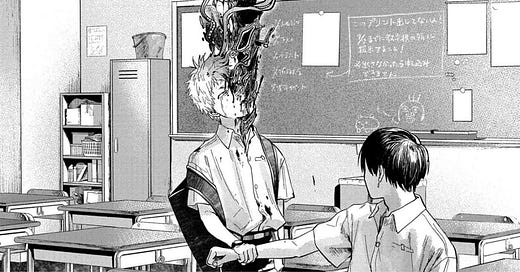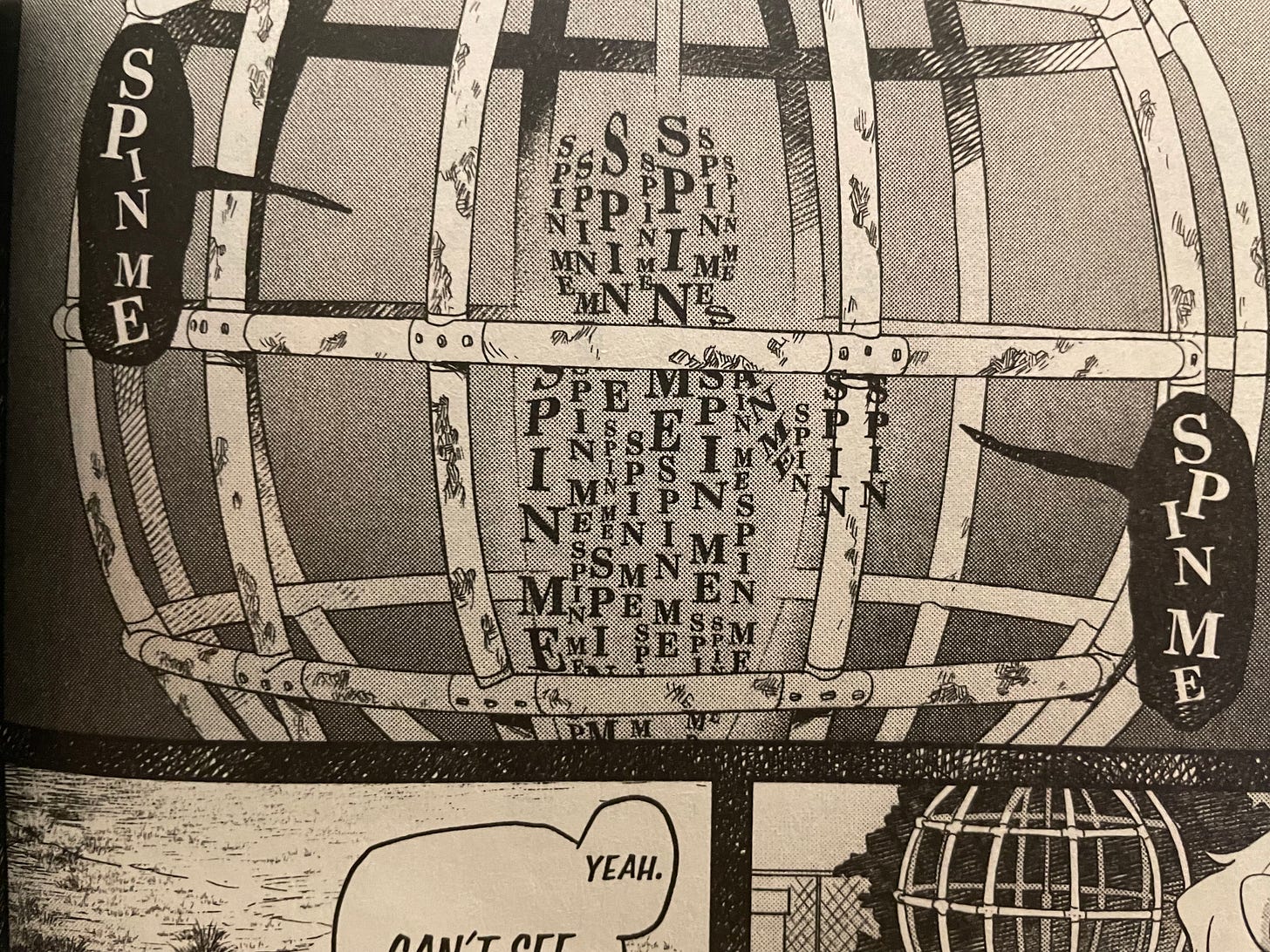The Summer Hikaru Died: The Subtlety of "What If..."
Don't play your hand until you know it's good.
Preface
I find it difficult to analyze manga early in their narrative journey. How can I properly assess a storytelling element by chapter seven? Choujin X, for instance, I can’t wait to write about, but I’m still too early to really grasp a tangible “check this out!” element.
The Summer Hikaru Died is different. It hits its vibe immediately. Last week (I think? What is time…) I looked at one great panel, and that great panel is literally on page seven. That panel, as you can read all about over there, sets the tone. That eerie, haunting, atmospheric tone that carries the story thus far.
It is many things, but above all others, it is subtle. And that is such an effective tool to wield when you do it right. One slip up though, one bit of “oversharing” and the dynamics completely change.
Preface over!
I’ve mentioned previously how I used to host a scary movie night every week back in college. How that has come up twice now on MangaCraft is beyond me, but here we are. The thing about horror movies, and horror in general, is it’s a fine line between holding the power of your narrative horror and losing it completely.
An example—The Tooth Fairy. No, not the one with The Rock, the “scary” one. That movie loses all, literally all, of its tension the moment you see the monster, because the monster just isn’t scary. It actually looks rather silly and fake. All the build-up is lost because of it. All the tension. Everything. Complete deflation.
An opposite example—The Babadook. Since you never see the actual monster, the movie never loses its position of power. It always leaves you wondering what this monster could really look like and what it’s truly capable of, because you only ever see shadows, or pictures in a book. You only ever see subtleties.
What works so well with those subtle choices—that bit of guarding your hand, if you will—is you essentially create an outline of a monster and let the reader/viewer fill in the space with what scares them most, mixed with uncertainty, which is terrifying in its own right. This uncertain, amorphous shape bends to the darkest corner of any given mind.
Show your hand—your monster—and you risk losing all that fear.
Enter The Summer Hikaru Died, my current horror fave. This series is a master of subtlety. It has a narrative confidence that doesn’t rely on flashy bang-bang moments (can I coin that phrase?) to capture a readership. It relies on the exact opposite. It relies on “what if…” subtlety, which I might also coin, who knows.
Thus far in the series, two different characters ask Hikaru (the monster, more or less, though he looks like an ordinary kid) what exactly he is. But he never really answers, he only hints. A creepy wink and nudge.
Here’s the thing, with any given story, the creator is in control of reader expectations. Of the boundaries of the narrative. Every time you expand the boundaries in your narrative, you show your hand, or at least some of it. You show the reader what the story is capable of. But there are so many edges to those boundaries. If you deliver a truly devastating character death, the reader now knows this story is capable of that, and the boundaries of the story expand. If you drop a joke so good it literally splits sides, you show the reader the level of humor you’re capable of and the boundaries expand. If you introduce a monster that is truly terrifying and capable of ripping the world apart, the reader knows the story can produce those types of monsters, and the boundaries of the story expand. And expand. And expand.
This is, actually, what I feel like a lot of action-based manga struggle with. Take Jujutsu Kaisen, for instance. I love it, but in the ongoing battle with Sukuna, I fear that Gege Akutami has overplayed his hand in terms of power. Sukuna is too powerful. The boundaries of the story have expanded too far, the readership has seen too much, and it’s making a resolution more and more difficult to find.
Take any other combat-based manga. My Hero Academia, One Piece, Black Clover. How do you keep raising the stakes when literally every villain nearly destroys the world? The boundaries are so vast to the point of being consistently unreachable.
The Summer Hikaru Died is completely different. By keeping the boundaries tight, every little nuance sets off so many “what if…?” alarm bells in the reader, because we just don’t know what this narrative is capable of yet. Aside from not-Hikaru showing his form and an old lady dying mysteriously (later revealed that not-Hikaru killed her), everything is speculation. Nothing is ever caught “on camera.”
Another example. The Haunting of Hill House (the TV show). This show does so much right, but one of the best horror elements is how the “scary parts,” or the supernatural elements, are rarely, if ever, the center of attention. They’re always happening in the background, out of focus, just out of sight. Opening up those wonderful “what if…?” moments. Those moments of not being sure what this story is capable of because the boundaries haven’t been so wantonly expanded, and I’m so glad I got to properly use the word wantonly.
In Volume 3 of Hikaru, Mokumokuren (our beloved mangaka) deploys a brand new type of subtlety. When it comes time to “see” a “monster,” rather than deploy an actual visual, Mokumokuren fills a shape with sounds. Let me show you… (pardon the photography, I’m reading the physical book).
For context, one of the characters, Asako, is taking the reader into her backstory, where we learn that she is capable of seeing distortions from the realm of the dead. Ghosts, pretty much, though this series may call them something else.
Rather than show us a ghost and risk losing all tension, Mokumokuren gives us a void filled with sounds. An uncertain shape, you could say.
Subtlety. The hand isn’t shown. We still have no clue what this distortion is, and similarly, we still have no idea what Hikaru is and what he’s capable of.
It’s funny, you may not consider this image…
…subtle, but think about it. What does it actually show us? It’s still an indefinable form. It’s still posing as Hikaru. We still know next to nothing about it or the danger it poses. Anything we suspect—that it’s powerful, nefarious, etc.—we are bringing to the story ourselves. We’re filling in the boundaries of uncertainty with our own materials. Remember The Babadook? Whatever you may think it looks like up close in the dead of the night, well that’s on you.
You know that adage that it’s often what’s left unsaid that… I forget how it goes, but the notion that what you don’t say speaks louder than what you do. The same goes with what you don’t show. Mokumokuren is not showing us anything more than a glimpse. A peripheral movement. A peek behind a dark curtain.
That’s a narrative gold mine, and Mokumokuren is taking his time mining it, as well he should. He is building up the tension one tiny step at a time, never pushing the boundaries of the story, thriving in this minimalistic horror that is working on pretty much every level.
Okay, this is turning into a gush-fest for The Summer Hikaru Died, so let’s tap out.
For creative writers: How can you withhold your hand until you really need to show it? What are some elements you can hint at, but not full reveal?
For fans of Hikaru: This may feel like a bland question, but it isn’t. How do you feel about not-Hikaru? Is he sympathetic? Villainous?








I think you nail what makes "Hikaru" (the monster) work so well at first, and it's interesting that even though we get more information about it later on and what/who it is stops being so blurry, the monster still works in another direction. Knowing that "Hikaru" is struggling to find its own identity just as Yoshiki struggles to categorize "Hikaru" makes the monster work because it's own monstrosity/otherness scares *it*. "Hikaru" wants to be part of Yoshikis life and live as the real Hikaru, yet fears that his own nature won't allow it. It also works so well as a metaphor for queerness.
This was an excellent breakdown - it's great seeing such a thorough analysis specifically focused on the tone of a series, which can be something difficult to articulate. Comparing/contrasting with action orientated manga and horror movies provides a solid frame of reference. All around incredible work, you've given me a lot to think about